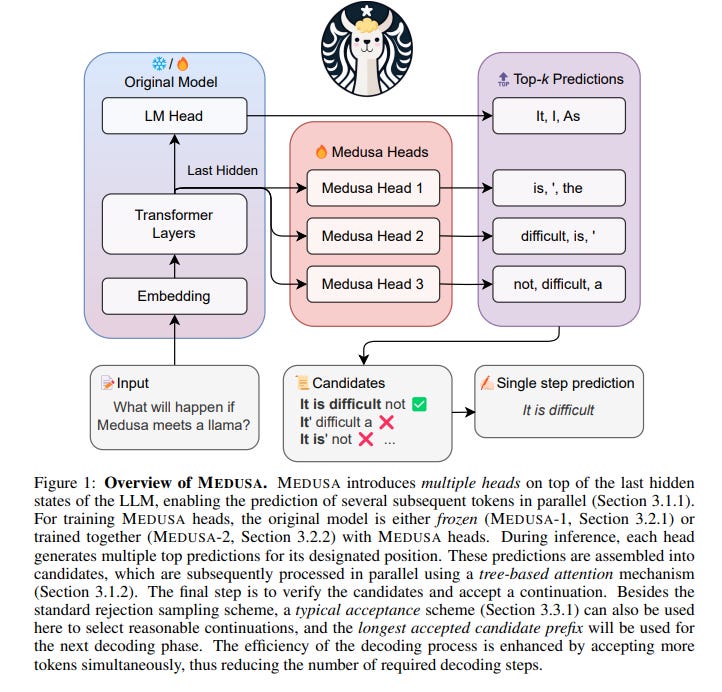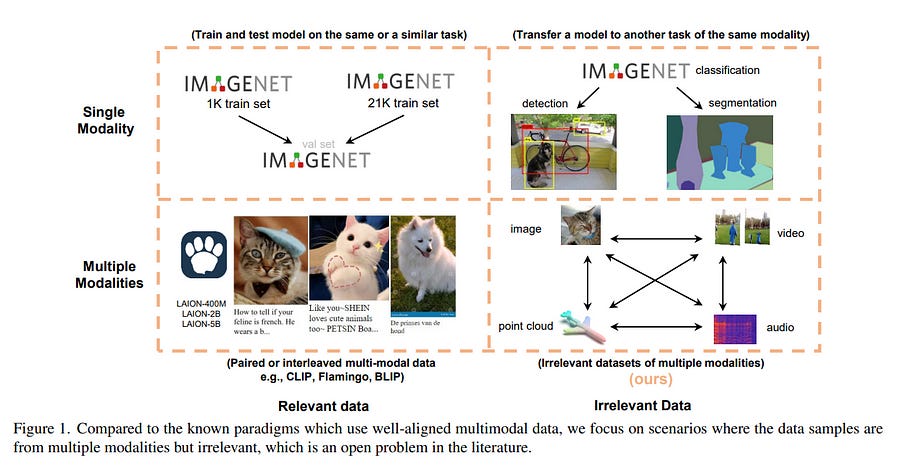Top Important LLM Papers for the Week from 22/01 to 28/01
Stay Updated with Recent Large Language Models Research
Large language models (LLMs) have advanced rapidly in recent years. As new generations of models are developed, researchers and engineers need to stay informed on the latest progress. This article summarizes some of the most important LLM papers published during the Fourth Week of January 2024.
The papers cover various topics shaping the next generation of language models, from model optimization and scaling to reasoning, benchmarking, and enhancing performance. Keeping up with novel LLM research across these domains will help guide continued progress toward models that are more capable, robust, and aligned with human values.
Table of Contents:
LLM Progress & Benchmarking
LLM Reasoning
LLM Training & Evaluation
Transformers & Attention Based Models
My E-book: Data Science Portfolio for Success Is Out!
I recently published my first e-book Data Science Portfolio for Success which is a practical guide on how to build your data science portfolio. The book covers the following topics: The Importance of Having a Portfolio as a Data Scientist How to Build a Data Science Portfolio That Will Land You a Job?
1. LLM Progress & Benchmarking
1.1. WebVoyager: Building an End-to-End Web Agent with Large Multimodal Models
1.2. MM-LLMs: Recent Advances in MultiModal Large Language Models
1.4. Rambler: Supporting Writing With Speech via LLM-Assisted Gist Manipulation
1.5. Genie: Achieving Human Parity in Content-Grounded Datasets Generation
1.6. MambaByte: Token-free Selective State Space Model
1.7. MaLA-500: Massive Language Adaptation of Large Language Models
1.8. SpacTor-T5: Pre-training T5 Models with Span Corruption and Replaced Token Detection
1.9. Depth Anything: Unleashing the Power of Large-Scale Unlabeled Data
1.11. Small Language Model Meets with Reinforced Vision Vocabulary
1.13. CheXagent: Towards a Foundation Model for Chest X-Ray Interpretation
1.14. Meta-Prompting: Enhancing Language Models with Task-Agnostic Scaffolding
1.15. Orion-14B: Open-source Multilingual Large Language Models
1.16. CMMMU: A Chinese Massive Multi-discipline Multimodal Understanding Benchmark
1.17. Spotting LLMs With Binoculars: Zero-Shot Detection of Machine-Generated Text
1.19. BiTA: Bi-Directional Tuning for Lossless Acceleration in Large Language Models
2. LLM Reasoning
2.1. DeepSeek-Coder: When the Large Language Model Meets Programming — The Rise of Code Intelligence
The rapid development of large language models has revolutionized code intelligence in software development. However, the predominance of closed-source models has restricted extensive research and development.
To address this, we introduce the DeepSeek-Coder series, a range of open-source code models with sizes from 1.3B to 33B, trained from scratch on 2 trillion tokens. These models are pre-trained on a high-quality project-level code corpus and employ a fill-in-the-blank task with a 16K window to enhance code generation and infilling.
Our extensive evaluations demonstrate that DeepSeek-Coder not only achieves state-of-the-art performance among open-source code models across multiple benchmarks but also surpasses existing closed-source models like Codex and GPT-3.5. Furthermore, DeepSeek-Coder models are under a permissive license that allows for both research and unrestricted commercial use.
3. LLM Training & Evaluation
3.1. Unitxt: Flexible, Shareable, and Reusable Data Preparation and Evaluation for Generative AI
In the dynamic landscape of generative NLP, traditional text processing pipelines limit research flexibility and reproducibility, as they are tailored to specific datasets, tasks, and model combinations.
The escalating complexity, involving system prompts, model-specific formats, instructions, and more, calls for a shift to a structured, modular, and customizable solution. Addressing this need, we present Unitxt, an innovative library for customizable textual data preparation and evaluation tailored to generative language models.
Unitxt natively integrates with common libraries like HuggingFace and LM-eval-harness and deconstructs processing flows into modular components, enabling easy customization and sharing between practitioners. These components encompass model-specific formats, task prompts, and many other comprehensive dataset-processing definitions.
The Unitxt-Catalog centralizes these components, fostering collaboration and exploration in modern textual data workflows. Beyond being a tool, Unitxt is a community-driven platform, empowering users to build, share, and advance their pipelines collaboratively.
3.2. Medusa: Simple LLM Inference Acceleration Framework with Multiple Decoding Heads
The inference process in Large Language Models (LLMs) is often limited due to the absence of parallelism in the auto-regressive decoding process, resulting in most operations being restricted by the memory bandwidth of accelerators.
While methods such as speculative decoding have been suggested to address this issue, their implementation is impeded by the challenges associated with acquiring and maintaining a separate draft model. In this paper, we present Medusa, an efficient method that augments LLM inference by adding extra decoding heads to predict multiple subsequent tokens in parallel.
Using a tree-based attention mechanism, Medusa constructs multiple candidate continuations and verifies them simultaneously in each decoding step. By leveraging parallel processing, Medusa introduces only minimal overhead in terms of single-step latency while substantially reducing the number of decoding steps required. We present two levels of fine-tuning procedures for Medusa to meet the needs of different use cases: Medusa-1: Medusa is directly fine-tuned on top of a frozen backbone LLM, enabling lossless inference acceleration.
Medusa-2: Medusa is fine-tuned together with the backbone LLM, enabling better prediction accuracy of Medusa heads and higher speedup but needing a special training recipe that preserves the backbone model’s capabilities.
Moreover, we propose several extensions that improve or expand the utility of Medusa, including a self-distillation to handle situations where no training data is available and a typical acceptance scheme to boost the acceptance rate while maintaining generation quality. We evaluate Medusa on models of various sizes and training procedures. Our experiments demonstrate that Medusa-1 can achieve over 2.2x speedup without compromising generation quality, while Medusa-2 further improves the speedup to 2.3–3.6x.
3.3. ConTextual: Evaluating Context-Sensitive Text-Rich Visual Reasoning in Large Multimodal Models
Recent advancements in AI have led to the development of large multimodal models (LMMs) capable of processing complex tasks involving joint reasoning over text and visual content in the image (e.g., navigating maps in public places).
This paper introduces ConTextual, a novel benchmark comprising instructions designed explicitly to evaluate LMMs’ ability to perform context-sensitive text-rich visual reasoning. ConTextual emphasizes diverse real-world scenarios (e.g., time-reading, navigation, shopping, and more) demanding a deeper understanding of the interactions between textual and visual elements.
Our findings reveal a significant performance gap of 30.8% between the best-performing LMM, GPT-4V(ision), and human capabilities using human evaluation indicating substantial room for improvement in context-sensitive text-rich visual reasoning. Notably, while GPT-4V excelled in abstract categories like meme and quote interpretation, its overall performance still lagged behind humans.
In addition to human evaluations, we also employed automatic evaluation metrics using GPT-4, uncovering similar trends in performance disparities. We also perform a fine-grained evaluation across diverse visual contexts and provide qualitative analysis which provides a robust framework for future advancements in the LMM design.
4. Transformers & Attention Based Models
4.1. Rethinking Patch Dependence for Masked Autoencoders
In this work, we re-examine inter-patch dependencies in the decoding mechanism of masked autoencoders (MAE). We decompose this decoding mechanism for masked patch reconstruction in MAE into self-attention and cross-attention.
Our investigations suggest that self-attention between mask patches is not essential for learning good representations. To this end, we propose a novel pretraining framework: Cross-Attention Masked Autoencoders (CrossMAE). CrossMAE’s decoder leverages only cross-attention between masked and visible tokens, with no degradation in downstream performance.
This design also enables decoding only a small subset of mask tokens, boosting efficiency. Furthermore, each decoder block can now leverage different encoder features, resulting in improved representation learning. CrossMAE matches MAE in performance with 2.5 to 3.7 times less decoding compute. It also surpasses MAE on ImageNet classification and COCO instance segmentation under the same compute.
4.2. Multimodal Pathway: Improve Transformers with Irrelevant Data from Other Modalities
We propose to improve transformers of a specific modality with irrelevant data from other modalities, e.g., improve an ImageNet model with audio or point cloud datasets. We would like to highlight that the data samples of the target modality are irrelevant to the other modalities, which distinguishes our method from other works utilizing paired (e.g., CLIP) or interleaved data of different modalities.
We propose a methodology named Multimodal Pathway — given a target modality and a transformer designed for it, we use an auxiliary transformer trained with data of another modality and construct pathways to connect components of the two models so that data of the target modality can be processed by both models. In this way, we utilize the universal sequence-to-sequence modeling abilities of transformers obtained from two modalities.
As a concrete implementation, we use a modality-specific tokenizer and task-specific head as usual but utilize the transformer blocks of the auxiliary model via a proposed method named Cross-Modal Re-parameterization, which exploits the auxiliary weights without any inference costs. On the image, point cloud, video, and audio recognition tasks, we observe significant and consistent performance improvements with irrelevant data from other modalities.
Are you looking to start a career in data science and AI and do not know how? I offer data science mentoring sessions and long-term career mentoring:
Mentoring sessions: https://lnkd.in/dXeg3KPW
Long-term mentoring: https://lnkd.in/dtdUYBrM












